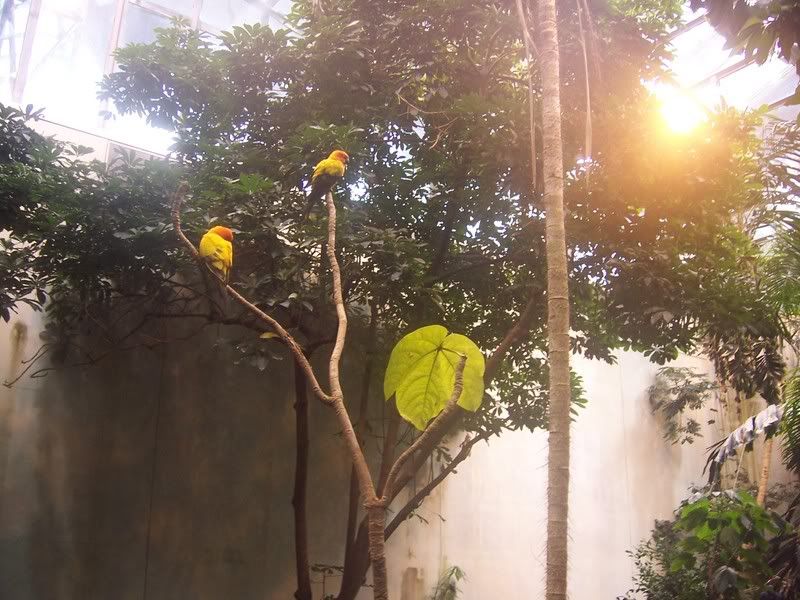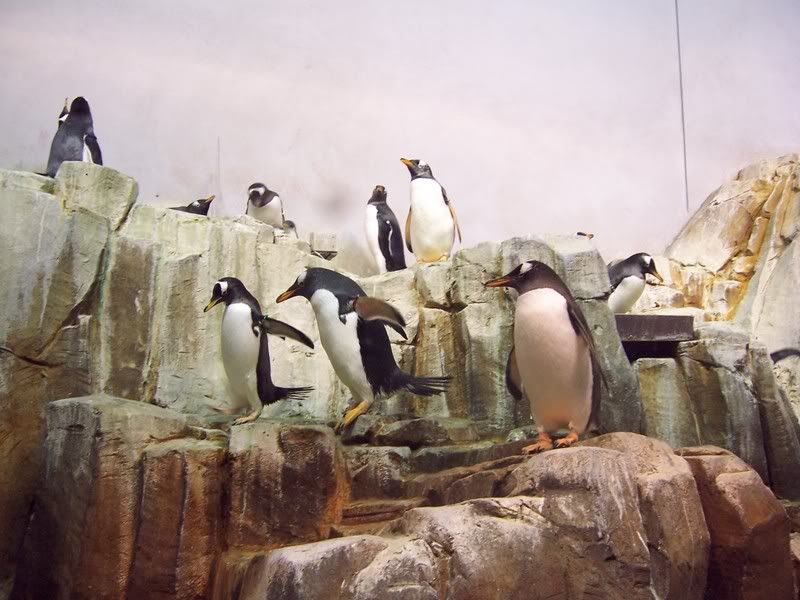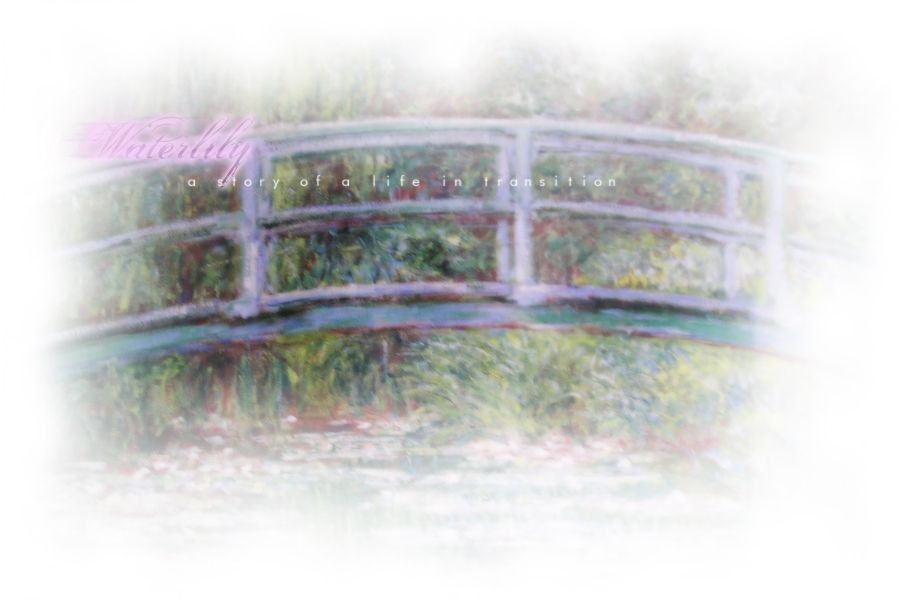: Finally, the big day! :
This is the second in a series of posts recounting my trip to Montreal and gender reassignment surgery with Dr. Pierre Brassard, which took place on January 8, 2007:
After our late arrival on Saturday night, we slept in Sunday morning at the apartment, finally rising to make breakfast. In the afternoon we went out for a few hours before dinner to explore the city. It was the first time in Montreal for my companions, but I had been here once before, in March 1996. Ironically, that was during my honeymoon, and I suppose it's fitting in a way that this city should serve as another milestone in my life more than a decade later.
We looked in a guidebook and found a place called the Biodome that looked interesting. It was a combination zoo, birdhouse and aquarium that showcases many different ecological environments under one roof. It was located in Olympic Park, part of the complex constructed for the 1976 Olympics, which includes Olympic Stadium, where the Montreal Expos used to play before they moved to Washington D.C. The Biodome was originally constructed as a sporting arena. One of my companions observed that with the massive stadium now empty and with so many buildings still standing that were built for events long forgotten, this part of the city feels old and used up, sort of halfway between the modern downtown and ancient Vieux Montreal, the historic part of the city. It bears noting that the 1976 Olympics were the most expensive Olympic Games ever organized, and left the city in debt for years afterward.
Apart from the generally lackluster exterior, inside the Biodome was surprisingly entertaining. The cavernous domed space was separated into several large sections that were dressed as different habitats. The first one was a tropical rainforest that housed tiny monkeys, alligators, parrots and other animals in a soaring free space. Next was a forested zone that had a wonderful beaver exhibit where you could not only see underwater to watch the beavers swim (one took a big poop while he was swimming) but there was even a camera inside the beaver's dam where you could watch him eat his meals. There was also an otter exhibit, but unfortunately it was empty that day.

The next room held a tidal area exhibit that included a small seashore for gulls and other seabirds, plus a wonderful glass-enclosed tidal pool that housed an incredible array of starfish, hermit crabs, anemone, coral and other reef animals. A walkway led to a large aquarium filled with many kinds of fish. Finally, there was an arctic exhibit of penguins, a somewhat smaller version of the penguin exhibit we saw at the Bronx Zoo.

When we got back, I did my first of two enemas, and then took a bath in the small Jacuzzi tub, which was to be my last bath for nearly a week, so I took my time about it. While my family ate dinner at the apartment, I walked around the corner and had my dinner with the other two trans-girls at the main house. One is Gene, a woman in her late 50s who lives in Maplewood, New Jersey - she and I are surgery partners. The other is Kaylyn, a woman in her mid-30s from New York. Her operation was scheduled for Tuesday.
After dinner I went back to the apartment to pack for the hospital and then we took the 10-minute drive over there. As we came in the door one of the nurses spied my Chalice Well pendant around my neck and asked about it. It was comforting to find a Wiccan nurse there and reminded me of the hotel in Virginia run by pagans that I stopped at last summer driving up from Houston. I unpacked my necessities and settled into the room that I was sharing with Gene. My companions and I played some board and card games until about 10 p.m. when I had to do my second enema and go to bed. While Gene asked for a sedative, I was surprisingly calm and didn't need one to sleep. I just felt fortunate to have made it this far and I was ready to get it done.
At 7 a.m. Dr. Brassard showed up and we went into a private room for our consultation. As I expected, when I showed him my tiny genitalia, he confirmed that I would need a skin graft to achieve functional depth. He said that my male parts were among the smallest he'd ever worked on, and if I had been one of his first 50 patients he would have been a little nervous, but now that he's done over a thousand of them, he feels comfortable with me. As I said before, this didn't come as a surprise to me that I would need a skin graft. Having small genitals has been a great benefit to me for the past 15 months that I've been full-time, obviating the need for tucking, or hiding them while wearing form-fitting clothes, even certain styles of bathing suits. But now I had to pay the price for the convenience.
A few minutes after my consultation Gene went off to surgery, and then we sat together and played more games until 12:30 p.m. when the nurse came to get me. I went into the surgical waiting room, where I laid down on a gurney and she covered me with a warm blanket. Dr. Brassard came in a few minutes later and said a few words of reassurance before the anesthesiologist came to see me. Since all my work was being done below the waist, the anesthesiologist offered two options - general or regional anesthesia.
General anesthesia is where they knock you out and your brain is essentially shut down into a coma-like state. Regional anesthesia is similar to the epidural that many woman receive during childbirth and I was familiar with it because it was used on my ex during my son's birth. I decided that I didn't want to go under general anesthesia since I didn't have to. I had done it last year for cosmetic surgery, and I had some difficulty waking up from it. So I opted for the regional anesthetic, which is administered through a needle into my spinal column in my lower back. He explained that I would be in a sleepy, dreamlike state, but not completely unconscious. This seemed a little unsettling as it didn't sound like I would be sufficiently "out" to avoid possibly becoming agitated during surgery, and I certainly didn't want to twitch or otherwise move while Dr. Brassard was working on me. But he assured me that I would be fine.
Once the decision was made, I was wheeled into the surgery room and placed on the table. An IV needle was inserted and taped into my left hand and they prepared my back for the anesthesia by scrubbing it with an iodine solution. Since I'm used to needles at this point from my twice-monthly self-injections of delestrogen, the needle in my back didn't really faze me much at all. Almost as soon as the needle was administered and I lay back down, I could feel my legs going tingly and numb as Dr. Brassard put them in stirrups above his head. That was pretty much the last thing I remember because seconds later the anesthesiologist gave me a sedative through the IV that made me fall asleep, although not to the point of having to assist me with breathing. Despite my concerns, I was completely insensate during the entire procedure and didn't feel or remember anything.
Coming up - recovery in the hospital
After our late arrival on Saturday night, we slept in Sunday morning at the apartment, finally rising to make breakfast. In the afternoon we went out for a few hours before dinner to explore the city. It was the first time in Montreal for my companions, but I had been here once before, in March 1996. Ironically, that was during my honeymoon, and I suppose it's fitting in a way that this city should serve as another milestone in my life more than a decade later.
We looked in a guidebook and found a place called the Biodome that looked interesting. It was a combination zoo, birdhouse and aquarium that showcases many different ecological environments under one roof. It was located in Olympic Park, part of the complex constructed for the 1976 Olympics, which includes Olympic Stadium, where the Montreal Expos used to play before they moved to Washington D.C. The Biodome was originally constructed as a sporting arena. One of my companions observed that with the massive stadium now empty and with so many buildings still standing that were built for events long forgotten, this part of the city feels old and used up, sort of halfway between the modern downtown and ancient Vieux Montreal, the historic part of the city. It bears noting that the 1976 Olympics were the most expensive Olympic Games ever organized, and left the city in debt for years afterward.
Apart from the generally lackluster exterior, inside the Biodome was surprisingly entertaining. The cavernous domed space was separated into several large sections that were dressed as different habitats. The first one was a tropical rainforest that housed tiny monkeys, alligators, parrots and other animals in a soaring free space. Next was a forested zone that had a wonderful beaver exhibit where you could not only see underwater to watch the beavers swim (one took a big poop while he was swimming) but there was even a camera inside the beaver's dam where you could watch him eat his meals. There was also an otter exhibit, but unfortunately it was empty that day.

The next room held a tidal area exhibit that included a small seashore for gulls and other seabirds, plus a wonderful glass-enclosed tidal pool that housed an incredible array of starfish, hermit crabs, anemone, coral and other reef animals. A walkway led to a large aquarium filled with many kinds of fish. Finally, there was an arctic exhibit of penguins, a somewhat smaller version of the penguin exhibit we saw at the Bronx Zoo.

When we got back, I did my first of two enemas, and then took a bath in the small Jacuzzi tub, which was to be my last bath for nearly a week, so I took my time about it. While my family ate dinner at the apartment, I walked around the corner and had my dinner with the other two trans-girls at the main house. One is Gene, a woman in her late 50s who lives in Maplewood, New Jersey - she and I are surgery partners. The other is Kaylyn, a woman in her mid-30s from New York. Her operation was scheduled for Tuesday.
After dinner I went back to the apartment to pack for the hospital and then we took the 10-minute drive over there. As we came in the door one of the nurses spied my Chalice Well pendant around my neck and asked about it. It was comforting to find a Wiccan nurse there and reminded me of the hotel in Virginia run by pagans that I stopped at last summer driving up from Houston. I unpacked my necessities and settled into the room that I was sharing with Gene. My companions and I played some board and card games until about 10 p.m. when I had to do my second enema and go to bed. While Gene asked for a sedative, I was surprisingly calm and didn't need one to sleep. I just felt fortunate to have made it this far and I was ready to get it done.
At 7 a.m. Dr. Brassard showed up and we went into a private room for our consultation. As I expected, when I showed him my tiny genitalia, he confirmed that I would need a skin graft to achieve functional depth. He said that my male parts were among the smallest he'd ever worked on, and if I had been one of his first 50 patients he would have been a little nervous, but now that he's done over a thousand of them, he feels comfortable with me. As I said before, this didn't come as a surprise to me that I would need a skin graft. Having small genitals has been a great benefit to me for the past 15 months that I've been full-time, obviating the need for tucking, or hiding them while wearing form-fitting clothes, even certain styles of bathing suits. But now I had to pay the price for the convenience.
A few minutes after my consultation Gene went off to surgery, and then we sat together and played more games until 12:30 p.m. when the nurse came to get me. I went into the surgical waiting room, where I laid down on a gurney and she covered me with a warm blanket. Dr. Brassard came in a few minutes later and said a few words of reassurance before the anesthesiologist came to see me. Since all my work was being done below the waist, the anesthesiologist offered two options - general or regional anesthesia.
General anesthesia is where they knock you out and your brain is essentially shut down into a coma-like state. Regional anesthesia is similar to the epidural that many woman receive during childbirth and I was familiar with it because it was used on my ex during my son's birth. I decided that I didn't want to go under general anesthesia since I didn't have to. I had done it last year for cosmetic surgery, and I had some difficulty waking up from it. So I opted for the regional anesthetic, which is administered through a needle into my spinal column in my lower back. He explained that I would be in a sleepy, dreamlike state, but not completely unconscious. This seemed a little unsettling as it didn't sound like I would be sufficiently "out" to avoid possibly becoming agitated during surgery, and I certainly didn't want to twitch or otherwise move while Dr. Brassard was working on me. But he assured me that I would be fine.
Once the decision was made, I was wheeled into the surgery room and placed on the table. An IV needle was inserted and taped into my left hand and they prepared my back for the anesthesia by scrubbing it with an iodine solution. Since I'm used to needles at this point from my twice-monthly self-injections of delestrogen, the needle in my back didn't really faze me much at all. Almost as soon as the needle was administered and I lay back down, I could feel my legs going tingly and numb as Dr. Brassard put them in stirrups above his head. That was pretty much the last thing I remember because seconds later the anesthesiologist gave me a sedative through the IV that made me fall asleep, although not to the point of having to assist me with breathing. Despite my concerns, I was completely insensate during the entire procedure and didn't feel or remember anything.
Coming up - recovery in the hospital

